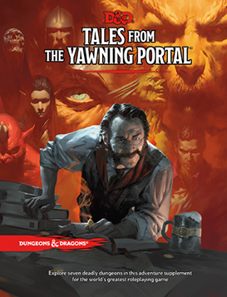 Wizards of the Coast have announced their first product of 2017. It’s a compilation of seven previous-published adventures, updated and revised for the new edition of Dungeons & Dragons. Its name? Tales from the Yawning Portal.
Wizards of the Coast have announced their first product of 2017. It’s a compilation of seven previous-published adventures, updated and revised for the new edition of Dungeons & Dragons. Its name? Tales from the Yawning Portal.
I’ve had the pleasure of playing or dungeon-mastering all seven of the adventures that will be released in this product, so it seems appropriate to do something extremely unusual: write a retrospective about the adventures contained in a product that hasn’t been released yet. This amuses me. So, these are retrospectives on my experiences with the adventures in their original printings.
Dungeons & Dragons owes a lot to the shared experiences of players playing adventures. Over the years it has been around, there have been a lot of adventures published, but only a few of them really approach classic status. Most of the adventures in this new product very easily meet the requirements to be considered classic, and they’ve all seen a lot of play.
It can be hard for new players to understand all the history of the game, so this product is a great introduction to it, helping people to discover the old adventures again, and to see some of the range of experiences that Dungeons & Dragons has to offer.
It should be noted that all of these adventures are very definitely dungeon adventures. As a result, it will be very easy to drop them into an ongoing game if you desire; although there’s nothing stopping you from playing through each adventure in order.
The Sunless Citadel
 Designed by Bruce Cordell. Dungeons & Dragons 3rd edition. Original Release 2000, character levels 1-2.
Designed by Bruce Cordell. Dungeons & Dragons 3rd edition. Original Release 2000, character levels 1-2.
The Sunless Citadel was the first adventure released for the Third Edition of Dungeons & Dragons. The year 2000 was an exciting time to be a D&D fan. Over the past few years, we’d watched in horror as TSR (the original publisher of D&D) had lost its way and eventually go bankrupt. The second edition was feeling old and tired, and the sale of TSR to Wizards of the Coast in 1997 promised exciting things. Finally, in 2000, we had it: a new edition of the game. And it was a major, major overhaul of the system – one that was far more amenable to expanding the system.
The Sunless Citadel is very much a dungeon adventure. After a couple of pages giving a brief description of the nearby town (and some rumours and quests to get players started), we’re into the dungeon: a fortress that sunk into the earth in a prior age, and now is inhabited by a number of dangerous inhabitants.
I didn’t run this as my first 3E session. A couple of weeks before the Player’s Handbook came out, I’d started up my homebrew Greyhawk campaign, and so I was inventing my own material for our first sessions. (Quite a lot of it, actually, as neither the Monster Manual nor Dungeon Master’s Guide were out, either!) However, I had a lot of friends interested in D&D, so it wasn’t long before I started up a new campaign that started with The Sunless Citadel.
For many people, the defining feature of The Sunless Citadel was the Keeper of the Dragons, named Meepo, a poor kobold who has lost his pet (a white dragon wyrmling), and was adopted by many groups as a mascot. We didn’t do so, and thus missed out on a lot of fun.
One of the aspects that makes The Sunless Citadel an interesting adventure is that the hooks and rumours all hint at different aspects of the citadel. There’s a feeling that you keep discovering secrets as you play the adventure. Three groups claim territory in sections of the dungeon, allowing the players a chance to see a more structured dungeon than just a collection of randomly-populated rooms.
The Forge of Fury
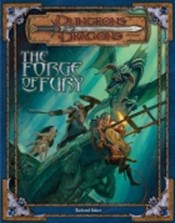 Designed by Richard Baker. Dungeons & Dragons 3rd edition. Original Release 2000, character levels 3-4.
Designed by Richard Baker. Dungeons & Dragons 3rd edition. Original Release 2000, character levels 3-4.
The Forge of Fury was the second adventure for Third Edition. Most people played it immediately after playing The Sunless Citadel, but, unlike today’s adventure paths, they weren’t related, except that there was a map in the first adventure that led to the second. It very much stood on its own. So, that means that if you just want to play this adventure, you can – you don’t need to play The Sunless Citadel first.
This adventure is very well-regarded. (It came in as the 12th-best adventure of all time in a 2004 poll). It’s another dungeon adventure, describing an abandoned stronghold made by the dwarven smith, Durgeddin. One of the main features of the dungeon is that it’s divided into five distinct sections, each section having its own character and set of encounters.
There’s one encounter in this adventure everyone talks about: a Roper down the bottom of the dungeon. In an adventure for 3rd-level characters, the Roper is rated as a challenge for 10th-level characters. It’s an intelligence test for players – are they smart enough to run or negotiate their way past the encounter? It should be noted that, in 3E, the Roper can talk. There’s a call-back to this encounter in Hoard of the Dragon Queen, but the designers didn’t realise that the 5th-edition Ropers can’t talk! How this encounter will play out in this adventure is anyone’s guess…
When I ran the adventure, negotiation wasn’t what the characters wanted to do. They wanted to kill the roper! And, in 3rd edition, the roper’s tendrils drained the target of 2d8 points of Strength! This was a great shock to the party. The cleric captured by the roper suddenly was drained to only two points of Strength, and the other party members had to cut him free and flee as quickly as they could.
I’ll admit that this is the adventure that, of the seven, I like the least. It’s a perfectly competent dungeon, but I never really warmed to it. I’m probably missing something. It’ll will be interesting to revisit it.
The Hidden Shrine of Tamoachan
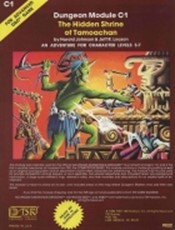 Designed by Harold Johnson and Jeff R. Leason. Advanced Dungeons & Dragons. Original Release 1980, character levels 3-7.
Designed by Harold Johnson and Jeff R. Leason. Advanced Dungeons & Dragons. Original Release 1980, character levels 3-7.
Many of the early D&D adventures were first used as tournament scenarios. A D&D tournament back then was much different from the game at conventions these days. You were competing against other groups, seeing how far you could get and how many of the encounters you could overcome. So, the encounters were a real test of your ingenuity and playing skill.
Tamoachan starts with the characters trapped in the bottom of a Mesoamerican-style ziggurat, with a poisonous atmosphere slowly choking them, and they have to get out through a number of very strange and inventive encounters. The logic behind the encounters tends to be “challenge the players” rather than what makes naturalistic sense, but what makes Tamoachan so memorable is all the references to Mesoamerican mythology. This gives the adventure a distinct style that feels very different to almost every other adventure published, before or after.
I ran it for my players last year as part of my D&D 5E Greyhawk campaign. (I was converting it on-the-fly). They found it a memorable experience, although there’s a lot of the encounter designs that didn’t make sense to them. Modern design is often very different to what you find here.
The publishing of Tamoachan as a normal scenario allows you to enter the ziggurat from the top, rather than having it as an escape scenario. That’s how I used it, and it’s likely such will be retained in the reprint.
One unusual fact about the original adventure: It was written for a group of exactly three characters. For a time when six to nine characters was more standard, this makes it very unusual.
Dead in Thay
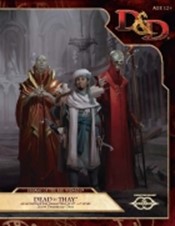 Designed by Scott Fitzgerald Gray. Dungeons & Dragons Next. Original Release 2014, character levels 6-8.
Designed by Scott Fitzgerald Gray. Dungeons & Dragons Next. Original Release 2014, character levels 6-8.
The current edition of Dungeons & Dragons didn’t happen overnight. Wizards of the Coast spent two years playtesting it before release. And it was a public playtest, with groups all around the world participating. In stores, the D&D Encounters program provided a large number of those people. As a cap-stone to the adventures, we got Dead in Thay, a multi-table dungeon where up to four groups could adventure through the dungeon at the same time.
That’s what happened at my local gaming store. We had three groups for most of the campaign, and ended with four. All who were exploring the dungeon, seeking the items required to defeat the Red Wizards and protect the Sword Coast from their invasion plans.
I wrote up a set of reports of the play here: Part 1, Part 2, Part 3, Part 4, Part 5, Part 6, Part 7
The multitable aspect of the adventure made it very memorable. I had monsters that fled from one group running into another. We kept track on a big board of where everyone was and which encounters had been overcome.
It’s hard to say how it will be released in this product, as it was a really big product. I expect we’ll only see one quarter of the map, and the multitable aspect removed. The original is one of my two favourite adventures in this product.
White Plume Mountain
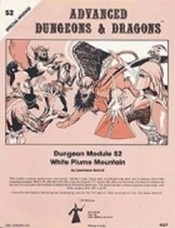 Designed by Lawrence Schick. Advanced Dungeons & Dragons. Original Release 1979, character levels 5-10.
Designed by Lawrence Schick. Advanced Dungeons & Dragons. Original Release 1979, character levels 5-10.
When Lawrence Schick applied to be hired as a designer at TSR, he sent them a sample adventure – the best bits of his home adventures, all put into the same adventure – to show what he could do. He was quite surprised when they published the adventure without changing a word! (Thus giving the D&D world Blackrazor, an intelligent sword which is just a little like Michael Moorcock’s Stormbringer).
White Plume Mountain has never been known as making a lot of sense. The plot is that a wizard who lives within White Plume Mountain has stolen three magic weapons and the players are hired to recover them. The dungeon is of a style known as a “funhouse dungeon” – it’s got a lot of encounters that don’t relate to each other that much, nor really to the fantasy world where they exist.
It is, however, an awful lot of fun to play. Not if you’re looking for a serious adventure, but if you just want to have fun, White Plume Mountain has it in spades. It’s also exceptionally deadly. I ran it a decade ago using the original rules, and we had a fantastic time. I also killed a lot of characters – or they killed themselves. Hard to say. Fireball in AD&D can really take out a party…
This is one of my two favourite adventures in this package. Yes, I really love the wacky encounters. Sometimes, you just want to have fun!
Against the Giants
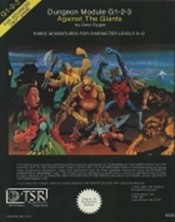 Designed by Gary Gygax. Advanced Dungeons & Dragons. Original Release 1978, character levels 8-12.
Designed by Gary Gygax. Advanced Dungeons & Dragons. Original Release 1978, character levels 8-12.
The very first adventures released for Advanced Dungeons & Dragons by TSR were the three modules of Against the Giants. They were slender adventures by later standards – 8 pages, 8 pages and 16 pages – but they were tremendously influential and well-regarded, especially once the succeeding trilogy of “D” adventures were released. Alas, Vault of the Drow is not part of this package, but the adventures in Against the Giants are a lot of fun.
One aspect of their design that is quite important is that the threat and complexity grows throughout the adventures. The first adventure, Steading of the Hill Giant Chief, is a simple design which has a set piece of the characters attacking a large number of hill giants (and their guests) who are attending a feast. Giants were weaker then compared to how they would become in later editions, though still being dangerous, so the magic-users would get to use fireball spells very effectively!
However, the environment of Glacial Rift of the Frost Giant Jarl is as much a threat as the monsters, and by the final adventure, the adventurers need to overcome the fiendishly intelligent (and powerful) Fire Giants. What began as a simple hack’n’slash adventure is anything but by the end, and the revelations as to who is behind everything would provide the game with its first iconic monster.
Against the Giants was the first adventure I tried to run, back in 1982. I didn’t have a clue what I was doing, and because the maps of the compilation adventure weren’t labelled, I had great trouble at working out which map corresponded to the Steading. It wasn’t the most memorable session, but it was the first I attempted to DM. Later on, I’d run the adventure again, and it was fascinating to see how more experienced players dealt with the giants.
Tomb of Horrors
 Designed by Gary Gygax. Advanced Dungeons & Dragons. Original Release 1978, character levels 5-14.
Designed by Gary Gygax. Advanced Dungeons & Dragons. Original Release 1978, character levels 5-14.
How new players will find Tomb of Horrors is probably not that much different to how the original players who played it found it: Stunned disbelief is my guess.
Gary Gygax designed this adventure to show players who had high-level characters but little play experience that there was more to D&D than just good statistics. As a result, it has become famed as the iconic Killer Dungeon. Many characters have entered the Tomb, few have returned.
Gygax’s original players – his son Ernie, and his friend Rob Kuntz – both were able to overcome the Tomb in their own ways, but it’s certain that most players weren’t familiar with Gygax’s style, and found it much more difficult. I first played the adventure in the 80s, and I was definitely not an expert player. I was playing a kender thief my DM gave me, and I soon found myself trapped without any possessions at all (and no clothes!) in an empty cell…
There’s not many monsters in Tomb of Horrors, but the tension is high throughout. There’s a lot of treasure in the end – if you claim it – and back in the day, this was very important, as you gained far more XP for treasure gained than monsters overcome.
Tomb of Horrors is an iconic adventure, although it is in no way what you normally want in a D&D adventure. Once designed, you didn’t need another adventure like it. Despite that, or perhaps because of it, it’s an adventure that is an important part of D&D lore, and one that will be fascinating to see used by new players – all of whom are likely to have new stories about how their characters died!


Well said
I wonder whether this will be the same Chris Perkins 5e conversion of Tomb of Horrors that appeared in Dungeon issue 213.
I’m very excited to see official 5e conversions of these classic adventures and hope that sales justify further releases along the same lines. Great short adventures is just what 5e needs IMO.
I was actually reading through the Chris Perkins DnD Next conversion a couple of nights ago and the next day WotC announced Yawning Portal. The same thought crossed my mind as well.
Nice Writeup as always, Merric!
I was disappointed by my expectations based on the title of the book. I was hoping for a Waterdeep Sourcebook with a shadow/political city campaign for season 6. 🙁